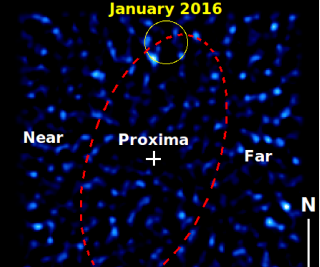Astronomers May Have Nabbed Image of Exoplanet Proxima C
With its relatively large size and distance from its star, Proxima c has been a tempting target for exoplanet-imaging ventures. Now, according to a paper accepted for publication in the journal Astronomy & Astrophysics, some astronomers say that they may have managed to image Proxima c for the first time.
Since the first confirmation of an exoplanet in 1995, there have been more than 4,000 such impressive discoveries. Taking images of them, however, has proven to be a difficult task considering that these exoplanets are many light-years away from Earth.
Now, perhaps, you can check off another box for these hardworking astronomers, as they believe that they’ve captured the first-ever image of Proxima c, a planet that orbits our nearest star, Proxima Centauri.
Proxima Centauri, a cool and faint red dwarf star, is located 4.2 light-years away, a short walk to a neighbor’s house in terms of distance in the cosmos.
In 2016, astronomers discovered the first known planet in this star system, which was named Proxima b. The Earth-sized planet whipped around its star in an 11-day tight orbit, and this fact made it a poor candidate for imaging.
Proxima c, however, is estimated to be several times more massive than our planet, and it orbits Proxima Centauri at about 1.5 times the distance between Earth and our sun, which is intriguingly in the habitable zone and could potentially have liquid water on its surface.
With its relatively large size and distance from its star, Proxima c has been a tempting target for exoplanet-imaging ventures. Now, according to a paper accepted for publication in the journal Astronomy & Astrophysics, some astronomers say that they may have managed to image Proxima c for the first time.
Proxima c is much brighter than astronomers had expected, which may mean that the planet is surrounded by a colossal disk of dust or even a brilliant system of rings.
Raffaele Gratton, of the Astronomical Observatory of Padova in Italy, and his colleagues used SPHERE, an instrument attached to the Very Large Telescope in Chile, to search for the reflected light off Proxima c.
The first image of an exoplanet was taken back in 2004, when the ESO successfully aimed its camera lens at the Jupiter-like exoplanet 2M1207 b as it orbited its brown dwarf star, 2M1207. This star system is located about 230 light-years away in the constellation Hydra.
For stargazers, images of exoplanets will have to do for now, as sending a spacecraft to Proxima Centauri, which is part of a triple-star system called Alpha Centauri, is next to impossible with our current technology.
Just to put these types of vast distances into perspective, take a gander at NASA’s New Horizons probe that completed several years back its 3 billion-mile journey to Pluto. That trip itself took nine and a half years. New Horizons was traveling at speeds that topped 52,000 mph, but even at that rate, it would take about 54,400 years to reach Proxima Centauri.
NASA’s Juno reached incredible speeds of about 165,000 mph when it entered into orbit around the gas giant Jupiter. Even at that rate, the probe would reach Proxima Centauri in about 17,160 years.
Ethen Kim Lieser is a Tech Editor who has held posts at Google, The Korea Herald, Lincoln Journal Star, AsianWeek and Arirang TV. He lives in Minneapolis with his wife and two cats.

